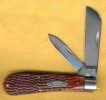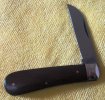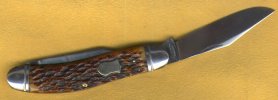-
The BladeForums.com 2024 Traditional Knife is available! Price is $250 ea (shipped within CONUS).
Order here: https://www.bladeforums.com/help/2024-traditional/
You are using an out of date browser. It may not display this or other websites correctly.
You should upgrade or use an alternative browser.
You should upgrade or use an alternative browser.
Half Hawk Blade
- Thread starter hughd
- Start date
- Joined
- Mar 26, 2004
- Messages
- 24,735
No oxycontin, I meant what I said, a new traditional pattern. This knife is definitely traditional. My search for a non-RR half hawk knife turned up zero. Unless Planterz or someone else finds one that predates the RR model, then RR made a new traditional pattern. The posts above don't agree on exactly what it is, so it must not be an old traditional pattern (to distinguish from new traditional pattern, no redundancy intended).
They've already been mentioned. Case 6217 Loom Fixer. 4" closed vs 4" closed, sheepsfoot main and pen secondary vs sheepsfoot main and pen secondary. It looks to me like RR took the 6217 and copied it pretty darn closely.
supratentorial mentioned that it's also called a New England Whaler. I've seen it called this elsewhere too. Sometimes a rope knife, although from what I gather a rope knife refers more to the blade rather than the handle, being a sheepsfoot or blunter at the tip (which would be a rope blade). The idea being that you'd have a sharp, stout edge with which to cut lines on a ship, be it either by typical cutting or using something to whack it with (mallet, belaying pin) through the rope. I've read that the tips of such knives were blunt so angry sailors wouldn't stab each other, or that since they often go barefooted it wouldn't penetrate if dropped, or that it wouldn't do the same if dropped from high up a sail or rigging.
I honestly don't know how or why this pattern would be useful for fixing looms, but I don't fix looms. I think Case is the only one that calls it a loom fixer, and others that get called that are probably because it looks like the Case. I'm no expert though.
Clearly though, it's not a new pattern that RR invented, and it's in fact quite old. I don't know what painkillers have to do with anything.
- Joined
- Dec 9, 2015
- Messages
- 392
I thought it was caller a ram's foot. Or maybe I'm just making that up, but...
Sheep's foot = blade and spine are paralell.
Lamb's foot = Spine drops towards tip
Ram's foot = Spine rises towards tip
Sheep's foot = blade and spine are paralell.
Lamb's foot = Spine drops towards tip
Ram's foot = Spine rises towards tip
waynorth
Dealer / Materials Provider
- Joined
- Nov 19, 2005
- Messages
- 33,346
Most of the knives with a wide distal end are intended for rope cutting. They are more likely to go all the way through the rope when tapped with a belaying pin, instead of half-way through.
Half a knife is no knife at all!!
Half a knife is no knife at all!!
- Joined
- Dec 19, 2006
- Messages
- 8,210
- Joined
- Dec 19, 2006
- Messages
- 8,210
I wonder who invented what...



and so on, &so...could add a dozen (at least) more, from France, Germany and Spain... Nothing new under the sun.
Is the "Le London" etch meaning that the pattern is a homage to an old pattern from England? Or is that a brand of some sort? I don't know the roots of the pattern. But I assumed it was from England. Wouldn't surprise me if it had old roots in Germany or France as well.
- Joined
- Dec 19, 2006
- Messages
- 8,210
Let me try it this way. Is the blade in question called a Sheepsfoot even though the spine and belly are not parallel?
yes
- Joined
- Dec 19, 2006
- Messages
- 8,210
Here's a photo of the "half hawk"


waynorth
Dealer / Materials Provider
- Joined
- Nov 19, 2005
- Messages
- 33,346
This blade has been mentioned. The knife is called a Loomfixer. Maybe someone can explain how that widened blade is used. I don't know exactly - it is easy to guess it is used to fix the warp or weft on a loom. Does anyone know for sure? It is not a sheepfoot.

Since a Sheepfoot's primary use was to trim hooves to keep sheep from getting crippled, a widened blade would be a detriment, making it harder to turn around a hoof as you trim it.
In fact I suspect a Lambsfoot blade makes a better "sheepfoot"!!
Go figure!!!

Since a Sheepfoot's primary use was to trim hooves to keep sheep from getting crippled, a widened blade would be a detriment, making it harder to turn around a hoof as you trim it.
In fact I suspect a Lambsfoot blade makes a better "sheepfoot"!!
Go figure!!!
- Joined
- Dec 19, 2006
- Messages
- 8,210
This blade has been mentioned. The knife is called a Loomfixer. Maybe someone can explain how that widened blade is used. I don't know exactly - it is easy to guess it is used to fix the warp or weft on a loom. Does anyone know for sure? It is not a sheepfoot.
View attachment 834211
Since a Sheepfoot's primary use was to trim hooves to keep sheep from getting crippled, a widened blade would be a detriment, making it harder to turn around a hoof as you trim it.
In fact I suspect a Lambsfoot blade makes a better "sheepfoot"!!
Go figure!!!
Is there a difference between the blade on that "loom fixer" and the blade on this "Whaler"? I would call the OP's "half hawk" a "New England Whaler" based on Levine's definition. Schrade made some with a nice "New England Whaler" blade etch.

waynorth
Dealer / Materials Provider
- Joined
- Nov 19, 2005
- Messages
- 33,346
Ha ha!! I like it!!
- Joined
- Dec 19, 2006
- Messages
- 8,210
I thought Case called it a sheepfoot but I don't think I've seen any really old ads from Case.
I'd need to check but I think Levine puts "New England Whalers" in the same general category as the larger "Rope Knives".
I'd need to check but I think Levine puts "New England Whalers" in the same general category as the larger "Rope Knives".
- Joined
- Dec 19, 2006
- Messages
- 8,210
Imperial? I like that 2/5 'belly. I like sowbelly knives in any fraction greater or equal to 1/5.
- Joined
- Jul 30, 2006
- Messages
- 44,227
No oxycontin, I meant what I said, a new traditional pattern. This knife is definitely traditional. My search for a non-RR half hawk knife turned up zero. Unless Planterz or someone else finds one that predates the RR model, then RR made a new traditional pattern. The posts above don't agree on exactly what it is, so it must not be an old traditional pattern (to distinguish from new traditional pattern, no redundancy intended).
You missed the post four above yours. OLD pattern.
The knife from RR is a curved jack or "New England Whaler"...some of the oldies were etched with that name. Very old pattern.
A swayback jack has a more extreme shape and has less heft to it. It is a smaller knife. The swayback jack from Tony Bose is stylized and a bit more moderate in shape to better suit modern tastes. To my knowledge nobody currently makes the knives with the same extreme shape of the oldies.
This is an example of a swayback jack

The knife on the bottom is a "New England Whaler". Tony's stylized design is somewhere in between the swayback and the New England Whaler. It is a lighter knife like the old swayback but the shape is more moderate.

- Joined
- Dec 2, 2005
- Messages
- 71,135
This blade has been mentioned. The knife is called a Loomfixer. Maybe someone can explain how that widened blade is used.
I believe it's primary use, like the British Tackler's Knife (below), would have been clearing blocked looms. So they would have had to cut through a lot of material (threads, cloth, fingers possibly) as quickly as possible, and the canted edge would have assisted that I would have thought


Last edited:




